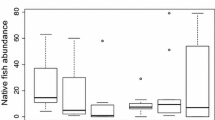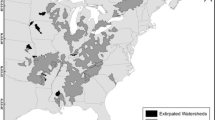Abstract
We tracked the spawning habitat use of two native stream gobies (Rhinogobius fluviatilis and Rhinogobius nagoyae) before and during the invasion of a non-native goby (Rhinogobius sp. OR) and after its disappearance in the Tani River, Japan. Throughout the three phases, the majority of the two native gobies showed high preference and use for the habitat with medium-fast current velocity and coarse substrates as spawning sites. When the non-native Rhinogobius sp. OR invaded, the majority of them also preferred and used the same habitat as spawning sites, and the spawning habitat use of the three Rhinogobius species substantially overlapped. These results suggest that the invasion by the non-native goby did not significantly change the spawning habitat use of the two native gobies. However, the similar habitat requirement among the three Rhinogobius species may cause competition for the spawning habitat when the availability of their favorite habitat is greatly restricted. The non-native Rhinogobius sp. OR could utilize the spawning space on the undersurface of nest stones more efficiently than the two native gobies. Therefore, in the non-native Rhinogobius sp. OR, the size of nest stones is unlikely to be a limiting factor for reproductive success. Such ecological characteristics on nest stone use may enable Rhinogobius sp. OR to easily acquire nest stones with less competition in the spawning habitat where they coexist, which have also helped Rhinogobius sp. OR to extend its distribution area.







Similar content being viewed by others
Data availability
Requests should be addressed to the corresponding author.
Code availability
Not applicable.
References
Arthington AH (1991) Ecological and genetic impacts of introduced and translocated freshwater fishes in Australia. Can J Fish Aquat Sci 48:33–43
Blair TC, McPherson JG (1999) Grain-size and textural classification of coarse sedimentary particles. J Sediment Res 69:6–19
Chesson J (1978) Measuring preference in selective predation. Ecology 59:211–215
Cucherousset J, Olden JD (2011) Ecological impact of non-native freshwater fishes. Fisheries 36:215–230
Gozlan RE, Britton JR, Cowx I, Copp GH (2010) Current knowledge on non-native freshwater fish introductions. J Fish Biol 76:751–786
Gray ES, Stauffer JR Jr (2001) Substrate choice by three species of dater (Teleostei: Percidae) in a artificial stream: effects of a nonnative species. Copeia 2001:254–261
Gray ES, Kellogg KA, Stauffer JR (2005) Habitat shift of a native darter Etheostoma olmstedi (Teleostei: Percidae) in sympatry with a non-native dater Etheostoma zonale. Am Midl Nat 154:166–177
Islands, Formosa, Kurile Islands, Korea and southern Sakhalin. Figures and descriptions of the fishes of japan 34: 629–644 (in Japanese and English)
Ito S, Yanagisawa Y (2000) Mate choice and cannibalism in a natural population of a stream goby, Rhinogobius sp. Ichthyol Res 47:51–58
Ito S, Yanagisawa Y (2003) Mate choice and mating pattern in a stream goby of the genus Rhinogobius. Environ Biol Fish 66:67–73
Ito S, Koike H, Omori K, Inoue M (2006) Comparison of current-velocity tolerance among six stream gobies of the genus Rhinogobius. Ichthyol Res 53:301–305
Ito S, Iwao H, Sakata J, Inoue M, Omori K, Yanagisawa Y (2016) Simultaneous spawning by female stream goby Rhinogobius sp. and the association with brood cannibalism by nesting males. J Fish Biol 89:1592–1602
Ito S, Tamura Y, Sato A, Onishi H, Shibuya M, Uchida Y, Inoue M, Omori K (2021) Occurrence and disappearance of a non-native goby Rhinogobius sp. OR in relation to hydrological conditions in the Kamo River, southwestern Japan. Ichthyol Res 69: (in press)
Jordan DS, Seale A (1906) Descriptions of six new species of fishes from Japan. Proc US Natl Mus 30:143–148
Katano O (1994) Aggressive interactions between the dark chub, Zacco temmincki, and the pale chub, Z. platypus, in relation to their feeding behaviour. Ichthyol Res 40:441–449
Kennard MJ, Arthington AH, Pusey BJ, Harch BD (2005) Are alien fish a reliable indicator of river health? Freshwater Biol 50:174–193
Kitano S (2004) Ecological impacts of rainbow, brown and brook trout in Japanese inland waters. Global Environ Res 8:41–50
Kitano S, Ohdachi S, Koizumi I, Hasegawa K (2014) Hybridization between native white-spotted charr and nonnative brook trout in the upper Sorachi River, Hokkaido, Japan. Ichthyol Res 61:1–8
Konishi M, Takata K (2004) Size-dependent male-male competition for a spawning substrate between Pseudorasbora parva and Pseudorasbora pumila. Ichthyol Res 51:184–187
Konishi M, Hosoya K, Takata K (2003) Natural hybridization between endangered and introduced species of Pseudorasbora, with their genetic relationships and characteristics inferred from allozyme analyses. J Fish Biol 63:213–231
Manly BFJ, Miller P, Cook LM (1972) Analysis of a selective predation experiment. Biometrics 30:281–294
Mizuno N (1989) Rhinogobius sp. CB and LD. In Kawanabe H, Mizuno N (eds), Freshwater Fishes of Japan. Yama-to-Keikokusha, Tokyo, pp 587–591 (in Japanese)
Okuda N, Ito S, Iwao H (2002) Female spawning strategy in Rhinogobius sp. OR: how do females deposit their eggs in the nest? Ichthyol Res 49:371–379
Oto Y, Masuda R (2019) Size-dependent habitat use in the stream goby Rhinogobius flumineus is affected by a larger sympatric congener. Ichthyol Res 66:393–399
Takahashi D (2013) Nest site use by two freshwater Rhinogobius gobies inhabiting Lake Biwa in Japan. Ichthyol Res 60: 263–267 Tanaka S (1925) Figures and descriptions of the fishes of Japan including Riukiu Islands, Bonin
Van Kessel N, Dorenbosch M, De Boer MRM, Leuven RSEW, Van der Velde G (2011) Competition for shelter between four invasive gobiids and two native benthic fish species. Current Zoology 57:844–851
Yamasaki YY, Nishida M, Suzuki T, Mukai T, Watanabe K (2015) Phylogeny, hybridization, and life history evolution of Rhinogobius gobies in Japan, inferred from multiple nuclear gene sequences. Mol Phylogenet Evol 90:20–33
Acknowledgements
We would like to thank Okuda N, Yanagisawa Y for discussion, Shimizu T, and Mizuno N for the helpful information and advice; Matsuhana M for the assistance during data collection; Kudo S, Kudo T, Miura M, Matsumoto K, and other members of the Kamogawa Fishermen’s Union for providing their facilities and kindness; and Janelli G. Garibay for reviewing the English text.
Funding
This study was supported by the River Environment Fund (REF: 16–1-(4)-33), in charge of the Foundation of River and Watershed Environment Management (FOREM), Japan, and by grants from the 21st Century COE program of the Center for Marine Environmental Studies, Ehime University, Japan.
Author information
Authors and Affiliations
Contributions
SI, MI, and KO conceived and designed the investigation. SI, YT, AS, HO, MS, and YU performed the fieldwork. SI and MI analyzed the data. All the authors contributed to the writing of the manuscript.
Corresponding author
Ethics declarations
Ethics approval
The survey was conducted with permission of the Ehime Prefectural Government based on Article 48 of the fisheries coordination regulations of the Ehime prefecture ordinance. The capture and use of study animals therefore comply with the prefectural ordinance on the fisheries coordination regulations as approved under laws of fisheries (Article 57 and 119) and aquatic resources conservation (Article 4) in Japan. In this study, all the captured fish were released alive near their site of capture after measurement.
Consent to participate
Not applicable.
Consent for publication
The authors consent to publication of the manuscript, which has not been previously published in any journal.
Competing interests
The authors declare no competing interests.
Additional information
Publisher's note
Springer Nature remains neutral with regard to jurisdictional claims in published maps and institutional affiliations.
Rights and permissions
About this article
Cite this article
Ito, S., Tamura, Y., Sato, A. et al. Effect of a non-native freshwater goby invasion on spawning habitat use of two native freshwater gobies. Environ Biol Fish 104, 1341–1351 (2021). https://doi.org/10.1007/s10641-021-01159-8
Received:
Accepted:
Published:
Issue Date:
DOI: https://doi.org/10.1007/s10641-021-01159-8




